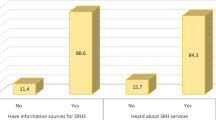Abstract
Reproductive health (RH) education and services of female migrants in China have become an important health issue. This research aimed to investigate the RH knowledge and utilization among married female migrants, and to explore the influencing factors from the perspectives of population and sociology. We conducted a cross-section survey in Shenzhen and Wuhan, China, using the purposive sampling method. A total of 1021 rural-to-urban married migrants were recruited, with 997 valid survey results obtained. A face-to-face structured questionnaire survey was used, with primary focus on knowledge of fertility, contraception, family planning policy and sexual transmitted diseases/acquired immunodeficiency syndrome (STD/AIDs), and RH service utilization. The results showed that the RH service utilization (38.0%) was at a low level in married migrants and the accessibility of RH service was poor. Females who migrated to (OR=0.32) Wuhan obtained fewer RH consultations than those in Shenzhen. The workers with high school education received additional RH consultations and checkup services than those with other background education, apart from the white collar workers who received extra RH consultations and checkup services than the blue collar workers (P<0.05). We can draw a conclusion that the utilization of RH services in married female migrants remains at a low level in China. RH service utilization can be improved via the relevant health departments by enhancing the responsibility of maternal and health care in the community health service center.
Similar content being viewed by others
References
Zheng ZZ, Zhou Y, Zheng LX, et al. Sexual behaviour and contraceptive use among unmarried, young women migrant workers in five cities in China. Reprod Health Matters, 2001,9(17):118–127
Bearinger LH, Sieving RE, Ferguson J. Global perspectives on the sexual and reproductive health of adolescents: patterns, prevention, and potential. Lancet, 2007,369(9568):1220–1231
Glasier A, Gülmezoglu AM, Schmid GP, et al. Sexual and reproductive health: a matter of life and death. Lancet, 2006,368(9547):1595–1607
Blanc AK. The effect of power in sexual relationships on sexual and reproductive health: An examination of the evidence. Stud Fam Plann, 2001,32(3):189–213
Kongsria S, Limwattananonb S, Sirilakc S, et al. Equity of access to and utilization of reproductive health services in Thailand: national Reproductive Health Survey data, 2006 and 2009. Reprod Health Matters, 2011,19(37):86–97
Yang XY, Li SZ, Feldman MW. Development and validation of a gender ideology scale for family planning services in rural China. PLoS One, 2003,8(4):e59919
Chen JJ, Liu HY, **e ZM. Effects of rural-urban return migration on women’s family planning and reproductive health attitudes and behavior in rural China. Stud Fam Plann, 2013,41(1):31–44
Wang CT. History of the Chinese family planning program: 1970-2010. Contraception, 2012,85(6):563–569
Baird DT, Evers JL, Gemzell-Danielsson K. Family planning 2011: better use of existing methods, new strategies and more informed choices for female contraception. Hum Reprod Update, 2012,18(6):670–681
Ding QJ, Hesketh T. Family size, fertility preferences, and sex ratio in China in the era of the one child family policy: results from national family planning and reproductive health survey. BMJ, 2006,333(7564):371–373
Li X, Stanton B, Fang X, et al. Social stigma and mental health among rural-to-urban migrants in China: A conceptual framework and future research needs. World Health Popul, 2006,8(3):14–31
Degni F, Suominen S, Essén B, et al. Communication and cultural issues in providing reproductive health care to immigrant women: health care providers’ experiences in meeting Somali women living in Finland. J Immigr Minor Health, 2011,14(2):330–343
Hu X, Cook S, Salazar MA. Internal migration and health in China. Lancet, 2008,372(9651):1717–1719
Kramer MA, van Veen MG, de Coul EL, et al. Migrants traveling to their country of origin: A bridge population for HIV transmission? Sex Transm Infect, 2008,84(7):554–555
Liu HY, Ru XM, Ding F. Reproductive health services for the floating population. Renkou Yanjiu (Chinese), 2004,28(5):92–96
Swain SN, Saggurti N, Battala M, et al. Experience of violence and adverse reproductive health outcomes, HIV risks among mobile female sex workers in India. BMC Public Health, 2011,11:357
Decker MR, McCauley HL, Phuengsamran D. Sex trafficking, sexual risk, sexually transmitted infection and reproductive health among female sex workers in Thailand. J Epidemiol Community Health, 2011,65(4):334–339
Lu CY, Xu LC, Wu J, et al. Sexual and reproductive health status and related knowledge among female migrant workers in Guangzhou, China: a cross-sectional survey. Eur J Obstet Gynecol ReprodBiol, 2012,160(1):60–65
Hesketh T, Ye XJ, Li L, et al. Health status and access to health care of migrant workers in China. Public Health Rep, 2008,123(2):189–197
Tsai SY, Sun WJ. Evaluating the satisfaction of immigrant women from a rural community regarding family functioning and health-related quality of life. Women Health, 2013,53(2):135–153
Liu Z, Zhu M, Dib HH, et al. RH knowledge and service utilization among unmarried rural-to-urban migrants in three major cities, China. BMC Public Health, 2011,11:74
Yang HU, Li Z, Chen HW. Analysis on the healthy reproduction demand and the service reach ability of women floating population in Baoan district of Shenzhen city. Yixue Yu Shehui (Chinese), 2006,19:19–21
Lian W, Liu GY, Shi SH. Floating population reproductive health services to get married men and evaluation. Zhongguo Shehui Yixue (Chinese), 2008,25:49–51
Li Z, Shi SH. Demand for and accessibility to RH service of urban floating population. J Huazhong Univ Sci Technolog Med Sci, 2005,25(5):608–611
Yang RC, **ao YH, **e XD, et al. Analysis on demand and utilization status of reproductive health service and influencing factors in rural married women of childbearing age. Zhongguo Fuyou Baojian (Chinese), 2013,28(27):4493–4495
State Council of People’s Republic of China. China’s action plan for reducing and preventing the spread of HIV/AIDS (2006–2010). State Council Document (2006) http://www.beinet.net.cn/zcfg/gh/qggh/200802/P020080423600734513667.
Chen P. Measures needed to strengthen strategic HIV/AIDS prevention programs in China. Asia Pac J Public Health, 2006,19:3–7
Author information
Authors and Affiliations
Corresponding author
Additional information
This project was supported by the National Social Science Foundation of China (No. ID10CRK009).
Rights and permissions
About this article
Cite this article
Liu, Zy., Li, J., Hong, Y. et al. Reproductive health service utilization and social determinants among married female rural-to-urban migrants in two metropolises, China. J. Huazhong Univ. Sci. Technol. [Med. Sci.] 36, 904–909 (2016). https://doi.org/10.1007/s11596-016-1682-8
Received:
Revised:
Published:
Issue Date:
DOI: https://doi.org/10.1007/s11596-016-1682-8




